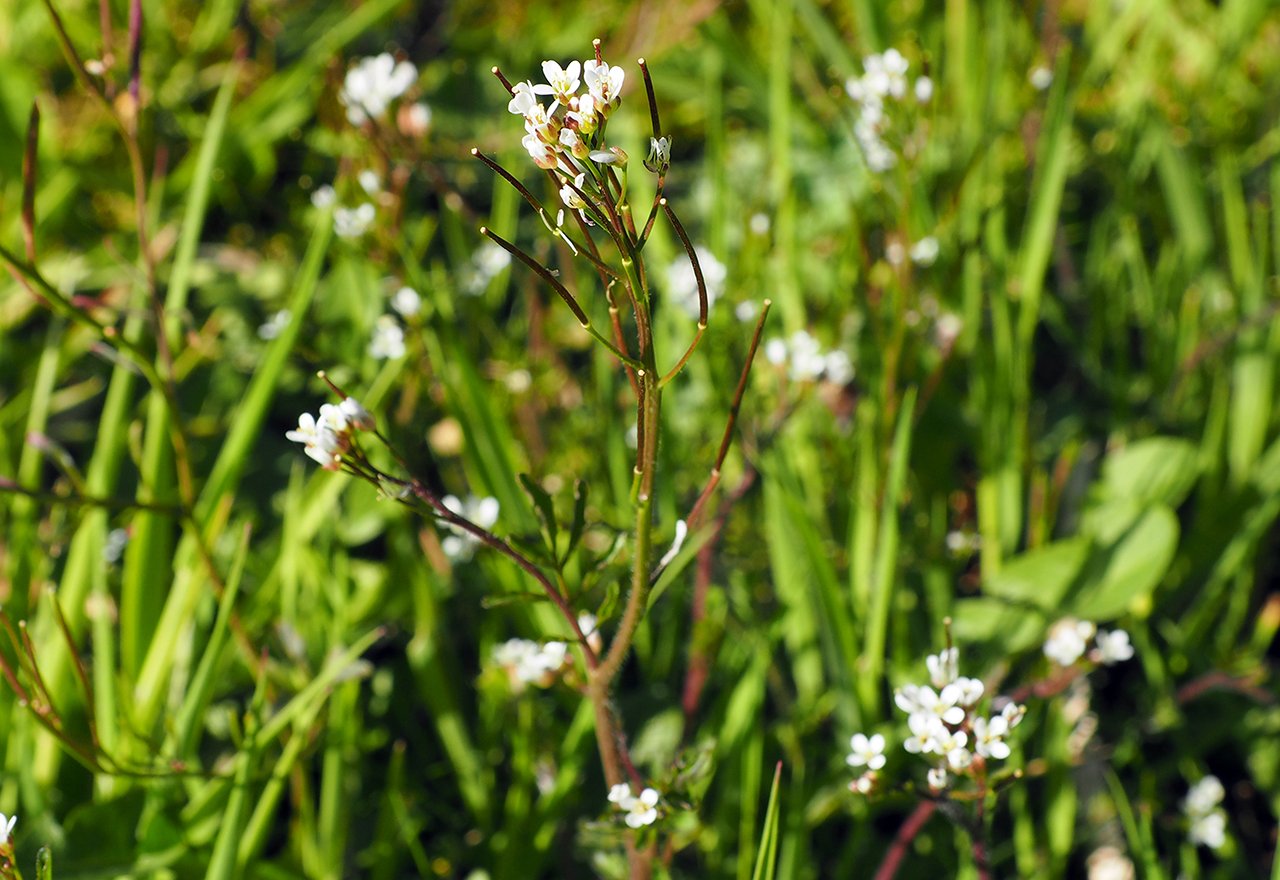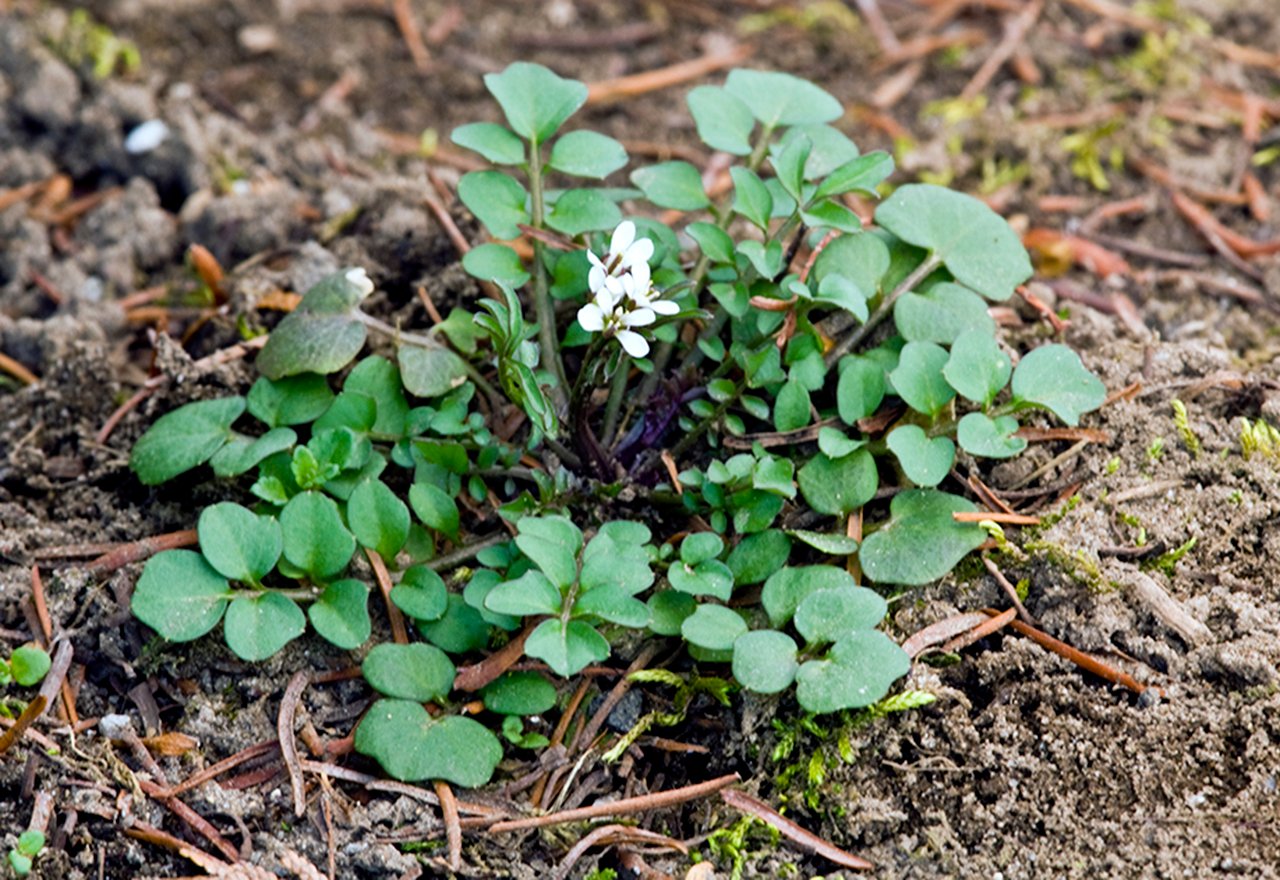A Fast Growing Winter Annual Weed with White Flowers, Visible in Spring

Hairy Bittercress, (Cardamine hirsuta), is a member of the mustard family and is considered a Winter annual weed. Sometimes the weed can act as a Summer annual or biennial, depending on the weather and climate. In the Midwest, it’s a Winter annual, which means the seeds overwinter, germinate sometime in the late Fall, and start growing in the Spring. Hairy Wintercress is one of the first weeds to emerge in gardens after the snows melt. Its quick growth and white flowers make it very recognizable as the weather starts to warm.
Hairy Bittercress has a rosette leaf growth pattern that is low to the ground. Lawnmowers will often only cut off the stems with flowers or seed pods, not low-growing leaves. Many stems of leaves grow from a middle root, forming the rosette. The leaves are rounded and hairy – the first leaves in the middle of the rosette are kidney-shaped but larger, outside leaves grow in pairs and are round. The end of each stem has a single, terminal leaf that’s also rounded.
Hairy Bittercress grows taller, branching stems for its flowers and seed pods, up to ten inches but usually three to five inches tall. The flowers are white and bloom in the Spring and into the Summer. They have four white petals and four yellow stamens. Once the flowers drop off, long purplish seed pods emerge and mature in the late Summer into Autumn. They’re called siliques and explode open and can propel seeds up to sixteen feet away. They will open when disturbed or once they are fully dried out after they’ve turned brown. The seeds will remain dormant over the Winter and then start to germinate in the Spring, starting the cycle over again.
Hairy Bittercress prefers moist soil but isn’t picky about a sunny spot or a shady location. It’s invasive and found throughout both the Western and Eastern United States as well as the South but does not live in the arid middle of the United States.
A little Hairy Bittercress is normal in your lawn and nothing to worry about since it’s an annual weed. A lot of Hairy Bittercress could indicate that you’re mowing your lawn too short in the late Summer and early Fall, that your lawn is not thick or healthy enough to compete with the weed, or that your grass types might not be strong enough to discourage weed growth. Hairy Bittercress has become much more prolific in recent years in our region.
Since Hairy Bittercress is an annual plant, the bulk of your effort should go into improving your lawn to prevent it next year. You will probably find more Hairy Bittercress in your gardens and driveway cracks than in your lawn.
Manually hand-pulling Hairy Bittercress works well since the roots are not deep or strong. Do your weeding before seed pods mature, otherwise, you will be planting the seeds and making more work for yourself next Spring. We recommend our favorite weeding tool, the Weed Out, which is appropriately nicknamed the “Speedy Weedy." It helps reach, twist, and pull weeds out without having to bend down.
If you have a large infestation, we can recommend a few natural weed killers including Burnout, Finalsan, and Captain Jack's Lawnweed Brew. Each of these weed killers are safe for kids and pets and won’t pollute waterways or groundwater. They are also safe for pollinators such as bees and butterflies.
Winter Annuals like Hairy Bittercress can be difficult to fight because they sprout in the late Fall. As with most annual weeds, the thicker your lawn is, the better able it will be to fight Hairy Bittercress. Regular feeding and overseeding, as necessary, can help keep your lawn thick and healthy and give it a little advantage over Hairy Bittercress. In addition, using a natural fertilizer with Corn Gluten Meal in the Fall (Like Our Healthy Lawn) may help reduce new Hairy Bittercress germination.
It could also be that the grass types you have are too old and weak and just don’t fight that well. If this is true for you, Lawn Renovation might be your best option. We will be happy to remove your turf and plant new grass for you. You can DIY your own new lawn with our recommended lawn seed mixture for our bioregion which includes 5% microclover, 90% Turf Type Tall Fescue, and 5% Kentucky Bluegrass. We sell a pre-made mix of the grass seed in our online store, Tuff Turf Lawn Seed, and sell bags of Microclover separately. If you don’t want to go that far, simply Slice Seeding grass into your existing lawn can also really help. We recommend adding some Microclover when Slice Seeding because the clover will remain green all Summer. Additionally, it's a legume, so it will add nitrogen into your soil and fertilize your lawn year-round.
If Hairy Bittercress is a big problem, you should try to avoid Core Aeration in the Fall. The reason we don't recommend Core Aeration is that it exposes soil to weed seeds just as the Hairy Bittercress is germinating. Liquid Aeration is a much better option to loosen your soil without giving Hairy Bittercress seeds a chance to sprout. Contact us to learn more or to get our opinion on what would be the best solution for your situation. We can perform the aeration for you or we sell a DIY product called Liquid Aerator in our online store.
Hairy Bittercress is a popular foraged plant. You can actually use Hairy Bittercress as a parsley substitute! Many foragers use it as a microgreen in salads or add it to sandwiches. It is not bitter but has a spicy, savory flavor. It is said to have high levels of vitamin C, calcium, magnesium, beta-carotene, and antioxidants. Additionally, the roots can also be blended with vinegar to make a dip similar to horseradish. As always, be sure to correctly identify any wild plant you consume.
